|
Adopt control measures only if the pest / disease population exceeds the economic
threshold levels.
Economic threshold levels (ETLs)
|
Crop stage and pest
|
Economic threshold levels
|
|
A. Nursery
|
|
1. Green leaf hopper
|
1-2 insects/m2
|
|
2. Gall midge
|
1 silver shoot (gall)/m2
|
|
3. Stem borer
|
1 moth or 1 egg mass/m2
|
|
4. Blast
|
5% disease severity
|
|
B. Planting to pre-tillering
|
|
1. Leaf folder
|
2 freshly damaged leaves/hill
|
|
2. Yellow stem borer
|
10% dead hearts or one egg mass or one moth/m2
|
|
3. Gall midge
|
1 gall/m2 in endemic areas or 5% affected tillers in non-endemic areas.
|
|
4. Brown plant hopper
|
5 to 10 insects/hill
|
|
5. Green leaf hopper
|
10 insects/hill (in RTV endemic areas 21 insects/hill)
|
|
6. White backed plant hopper
|
10 insects/hill
|
|
7. Rice Hispa
|
2 adults or 2 damaged leaves/hill
|
|
C. Mid-tillering
|
|
1. Leaf folder
|
2 freshly damaged leaves/hill
|
|
2. Stem borer
|
10% dead heart or 1 moth or 1 egg mass/m2
|
|
3. Gall midge
|
10% silver shoots
|
|
4. Brown plant hopper
|
10 insect/hill
|
|
5. Green leaf hopper
|
10-20 insects/hill
|
|
6. Hispa
|
2 adults or 2 damaged leaves/hill
|
|
7. Blast
|
Light (5-10% disease severity)
|
|
8. Bacterial blight
|
Light (2 to 5% disease severity)
|
|
9. Sheath blight
|
10% or more affected tillers
|
|
10. Tungro
|
1 affected hill/m2
|
|
D. Panicle initiation to booting
|
|
1. Stem borer
|
1 egg mass or 1 moth/m2
|
|
2. Leaf folder
|
2 freshly damaged leaves/hill
|
|
3. Green leaf hopper
|
20 insects/hill
|
|
4. Brown plant hopper
|
15 to 20 insects/hill
|
|
5. White backed plant hopper
|
15 to 20 insects/hill
|
|
6. Blast
|
5 to 10% leaf area damaged
|
|
7. Bacterial blight
|
Light to moderate (2-5% disease severity)
|
|
8. Sheath blight
|
10% or more tillers affected
|
|
E. Flowering and after
|
|
1. Brown plant hopper
|
25 to 30 insects/hill
|
|
2. Climbing cutworm
|
4-5 larvae/m2
|
|
3. Rice bug
|
1 or 2 bugs/hill
|
|
4. Blast
|
5% leaf area damaged or 1 to 2% neck infection
|
|
5. Sheath rot / brown spot / slight panicle discolouration
|
2-5% tillers affected
|
|
6. Sheath blight
|
10% or more tillers affected
|
|
7. Stem borer
|
2% white ear head
|
Source: Manual on Integrated Pest Management in Rice, Directorate of Plant
Protection, Quarantine and Storage.
Note:
(1) The population should be estimated on the basis of careful and regular surveillance.
(2) When natural enemies of brown plant hopper, green leaf hopper, stem borers and
leaf folders are present, application of chemical measures can be delayed or dispensed
with.
Pests
Rice
stem borer (Scirpophaga incertulas)
Symptoms
In the vegetative phase, the central shoot dies off turning yellow in colour (dead
heart). In the ear bearing stage, the ear head appears completely chaffy and white
in colour (white ear head). Both come out easily when pulled up and show indication
of feeding injuries at the base.
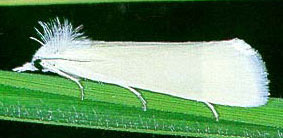
|
|
|
Scirpophaga incertulas
|
New emergence
|
|
|
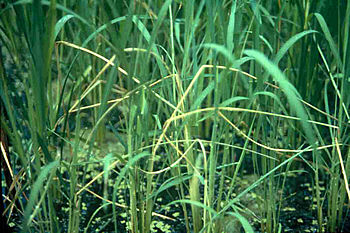
|
|
Whitehead or dead panicles
|
Drying of central tiller
|
Management
- Collect egg masses from the nursery plants and observe for parasitisation.
-
Cultivate tolerant varieties like IR-20 in endemic areas.
- In areas where stem
borer occurs as a serious pest in all seasons, apply any one of the following insecticides
first 15-20 days after transplantation and then at the boot leaf stage keeping minimum
water level: quinalphos (spray or granules), carbosulfan, cartap hydrochloride
(spray or granules), Flubendiamide, indoxacarb, malathion or spinosad, Fipronil, Chlorantraniliprole..
- Use sex
pheromone for the control of rice stem borer as given in the table below:
Sex pheromone used for the control of rice yellow stem borer (ad hoc recommendation)
|
Chemical name of the pheromone
|
2-(z)-9-heaxadecanol 2-(z)-11-hexadecemol in 1:3 identified from female moths
|
|
Sex attracted
|
Male moths
|
|
Description of the trap
|
Sleeve trap with pheromone loaded rubber septa
|
|
Uses
|
Pest monitoring: 3 traps can be fixed in a triangular fashion at about 80 m apart
|
|
Mating confusion
|
|
Number of traps required/ha
|
Twenty
|
|
Sources of availability
|
Entomology Department, Directorate of Rice Research, Rajendra Nagar, Hyderabad.
|
|
Pest Control India limited, Bio-control Research Laboratories P.O. Box. 6426, Yelahanka
P.O., Bengaluru-560 064 Karnataka
|
|
Ecomax Agrosystems 302, Faigha Plaza Basher Bagh, Hyderabad.
|
|
Dr. David Hall and Dr. Allen Cork, Natural Resources Institute, Kent ME4, 4TB, United
Kingdom.
|
|
The Managing Director, Som IPM System (India) Ltd., Plot No.101 1 Floor, Srinagar
Colony, Hyderabad.
|
Gall midge (Orseolia
oryzae)
Symptoms
Presence of silver shoot in the place of central leaf is the prominent symptom.
The symptom appears from the nursery to the flowering stage. However, in very young
seedling the silver shoots are not always expressed. Instead, a swelling at the
basal portion and excess tillering are often noticed.
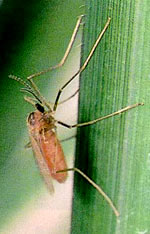
|
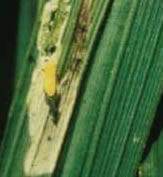
|
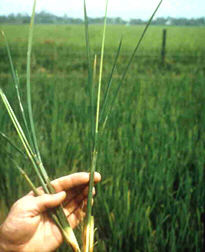
|
|
Gall midge
|
Feeding site of immature gall midge
|
Infected tillers
|
Management
1. Use tolerant varieties like Pavithra, Panchami and Uma.
2. Avoid late transplantation during the first crop season.
3. Careful monitoring of the crop seasons in the month of July during additional
crop season and October during puncha season.
4. Use optimum seed rate of 100 kg/ha.
5. Destruction of collateral host like wild rice, Cynodon dactylon, Ischaemum aristatum,
Echinochloa spp. and Isachne sp.
6. Dipping germinated seed in 0.2% chlorpyrifos solution for 3 hours before sowing
give protection up to 30 days.
7. In transplanted crop the root of seedlings may be dipped in 0.02% chlorpyrifos
suspension for 12 hours prior to planting.
8. The nursery treatment has to be followed by main field treatment, 10-15 days
after transplantation using anyone of the following insecticides: quinalphos. Carbosulphan 6G,
Chlorantriniliprole 4 G, and Fipronil.
9. In areas where the pest is of regular occurrence, apply granules of quinalphos
(250 g ai/ha) or chlorpyrifos 10G (0.5 kg ai/ha) within 10 days after sowing. The
granules should be broadcast in 2-3 cm of water and the field should be impounded
for at least 4 days.
Rice bug (Leptocorisa
acuta)
Symptoms
Look for the presence of bug in the field during the early ear bearing stage. Due
to de-sapping, grains show brownish discoloured patches on the husk.
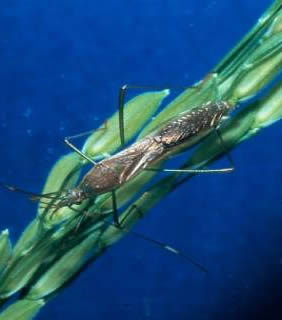
|
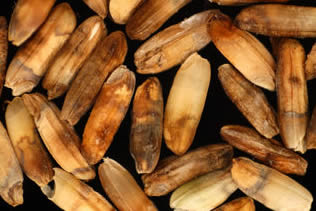
|
|
Rice bug adult
|
Affected rice grains
|
Management
1. Strict vigilance is necessary at milky stage.
2. Keep the field and bunds free of weeds and grasses.
3. Avoid overlapping cultivation in an Ela.
4. When the bug is seen in large numbers apply one of the following insecticides:
Malathion and carbaryl.
Note: Since the occurrence of the bug coincides with the flowering stage, application
of the insecticide may be done either before 9 a.m. or after 3 p.m. so that fertilization
of the flowers is not adversely affected.
Leaf
folder (Cnaphalocrocis medinalis)
Symptoms
The leaves of the plant are seen folded, rolled and often webbed together with white
patches on them indicating the areas fed by caterpillar. When such folded leaves
are opened up, larvae can be seen. Shaded conditions and application of excess nitrogen
are conducive for leaf folder attack.
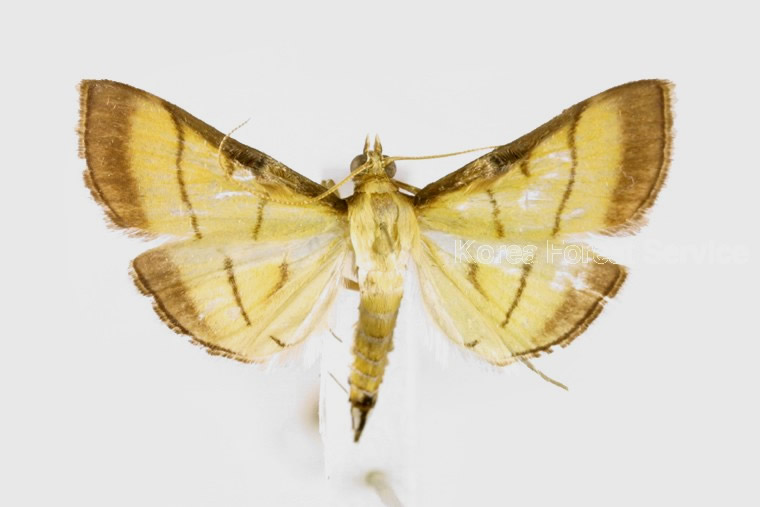
|

|
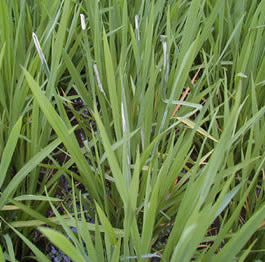
|
|
Cnaphalocrocis medinalis
|
C. medinalis larva
|
Leaf folds
|
Management
1. Open up the leaf folds with the help of a thorny twig.
2. Apply one of the following insecticides in the field where the symptoms of attack
are manifested: quinalphos, phosalone, cartap hydrochloride, flubendiamide,
acephate, indoxacarb and dichlorvos, Carbosulphan 6G, Chlorantriniliprole 4 G.
Note: - In the initial stages restrict spraying to infested patches only. The field
may be sprayed completely in case the infestation occurs uniformly.
Eco-friendly management:
1. Trichogramma japonicum and T. chilonis each @ 1 lakh/ ha + Beauvaria bassiana @ 10gm/ litre
2. Chitin based pseudomonas @ 2.5 kg/ha, Bacillus thuringiensis @ 200 g/ha,
fish jiggery extract @ 6ml/litre, azadiractin 1% @ 750 ml/litre.
Brown
plant hopper (Nilaparvata lugens)
Symptoms
Yellowish circular patches appear here and there in field. The plants in these areas
dry up very soon (hopper burn) and the yellowing and drying extend rapidly. Examine
the plants as soon as the yellowing appears. Presence of the hoppers at the base
of the plants confirms the infestation. Very close planting leads to enhanced attack.
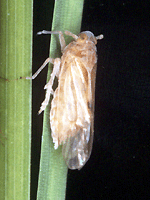
|
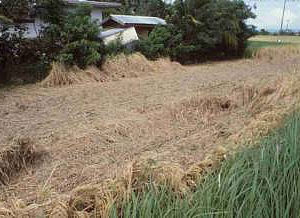
|
|
Nilaparvata lugens
|
Damaged field
|
Management
1. Use resistant varieties such as Jyothi, Bharathi, Aiswarya, Kanakom, Nila etc.
for cultivation.
2. Apply one of the following insecticides as soon as the yellowing symptom is observed,
covering the infested patches and the areas surrounding the patches: Buprofezin, ethofenprox, quinalphos,
thiamethoxam, acephate, phosalone and imidacloprid. While spraying and dusting,
care has to be taken to see that the insecticides reach the base of the plants.
3. Drain away water from the field and keep it in that conditions until the pest
population dwindle.
4. In Kuttanad tract, early planting of paddy in September-October is advisable,
wherever possible.
Rice
case worm (Nymphula depunctalis)
Symptoms
Leaves of plants are eaten by the caterpillars, which remain within small cylindrical
cases and are seen hanging on the leaves. It occurs in ill drained fields. The cases
may be seen floating on water also.
|
|
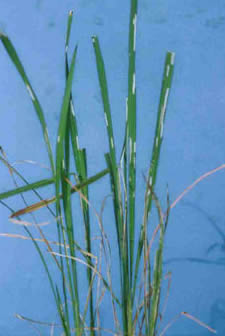
|
|
Nymphula depunctalis
adult
|
|
|
|
Floating cases
|
Damaged leaves
|
Management
1. Drain away the water from the fields.
2.
eco- friendly management: Chitin based pseudomonas @ 2.5 kg/ha, Azadiractin 1% @ 750 ml/litre
Rice
swarming caterpillar (Spodoptera mauritia)
Symptoms
It appears in the field sporadically and cyclically in large swarms and feed on
crops gregariously. The nursery and early stages of the crop are attacked leaving
the plant as mere stumps.
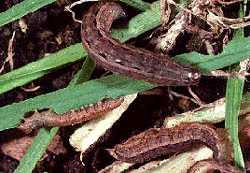
|
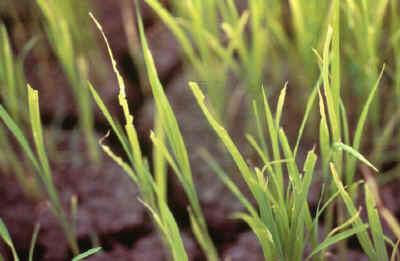
|
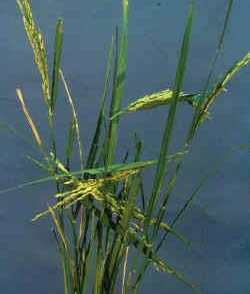
|
|
Spodoptera mauritia
|
Damaged leaf blades
|
Panicle damage
|
Management
Flood the fields or apply trichlorphon as soon as the caterpillars are noticed.
Rice
hispa (Dicladispa armigera)
Symptoms
The adults feed on the green tissues of the leaves and the feeding scars appear
as short white lines on the leaf surface. The grubs mine the leaves causing formation
of white blotches. Early stages of the crop are more susceptible.
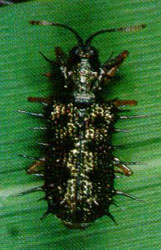
|
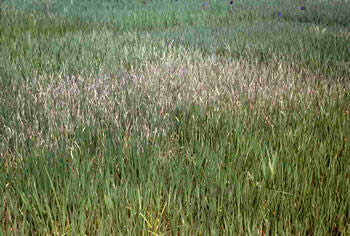
|
|
Dicladispa armigera
|
Field damage
|
Management
Spray any contact insecticide.
Rice
thrips (Stenchaetothrips biformis)
Symptoms
The crop is highly susceptible in the nursery stage for the first 23-25 days after
transplanting/sowing. The tips of leaves get rolled longitudinally into needle like
outgrowths and turn whitish. In severe cases, the lower leaves also turn yellowish.
The infestation may be rated as mild, if there is less than three needle like leaves
and as severe, if there are more than three outgrowths with the lower leaves also
showing chlorosis and scorching.
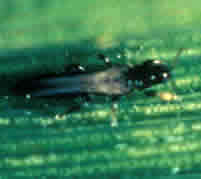
|
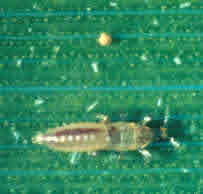
|
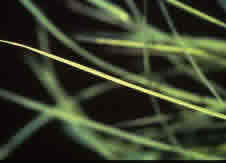
|
|
S. biformis adult
|
S. biformis larva
|
Leaf curls
|
Management
In severe infestations, apply DDVP 100% EC/AF 250 ml/ha or
dimethoate or quinalphos or phenthoate (EC/AF formulation).
Whorl
maggots (Hydrellia philippina)
Infestation is common in the nurseries and in the main fields up to six weeks after
transplantation. Yellowish patches and streaks are seen along the margins of leaves,
which may become deformed.
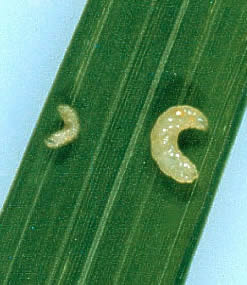
|
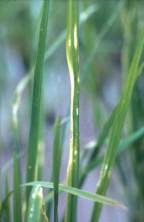
|
|
Hydrellia philippina
|
Leaf damage
|
Management
Apply malathion if infestation is severe.
Leaf
hoppers (Nephotettix spp.)
Symptoms
General yellowing of the leaves is seen, if the attack is severe. When the plants
are disturbed, the jassids are seen jumping out.

|
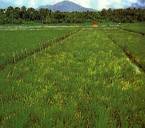
|
|
Nephotettix spp.
|
Damage in the field
|
Management
Apply quinalphos, flubendiamide or imidachloprid if needed.
Rice
mealy bug (Brevennia rehi)
Symptoms
Weak yellowish stunted plants are seen in patches. White waxy fluff is seen in leaf
sheaths.
Management
Dimethoate at 0.05% is effective in controlling the pest.
Rice
root nematode (Hirschmanniella oryzae)
Symptoms
Infests paddy roots and make them partially hollow. Feeding adversely affects absorption
of water and nutrients. Plants show stunted growth in patches. Tiller production
is affected.
Management
Dip the roots of seedlings in 0.2% dimethoate for six hours before transplanting
in tracts were nematode attack is detected.
Rice cyst nematode (Heterodera oryzicola)
The cyst nematode occurs in various proportions in certain areas
of state. The symptom of infestation include leaf chlorosis,
stunting, and reduction in number of leaves, earhead
lenth etc..in seriously affected patches, the yield is reduced.
Insecticide guide for rice pest control
|
Insecticide
|
*Dosage
|
Insect controlled
|
|
Acephate
|
800 g of 75 SP / ha
|
Rice leaf folder, Brown plant hopper
|
|
Carbosulfan
|
17kg of 6 G / ha
|
Rice stem borer, gall midge, leaf folder
|
|
Cartap hydrochloride
|
25 kg of 4 G / ha
|
Rice stem borer and leaf folder
|
|
Cartap hydrochloride
|
1 kg of 50 SP/ha
|
Rice stem borer and leaf folder
|
|
Chlorpyriphos
|
0.2% suspension
|
Germinated seed dip for 3 hours against gall midge
|
|
0.02% suspension
|
Seedling root dip for 12 hours against gall midge
|
|
Dichlorvos or DDVP
|
500 ml of 100 EC/AF / ha
|
Rice leaf folder, gall midge, leaf folder
|
|
Dimethoate
|
0.2% suspension
|
For seedling dip against rice nematode
|
|
0.05% suspension
|
For foliar application against thrips
|
|
Flubendiamide
|
125gof 20 WDG/ha
|
Rice stem borer, whorl maggot and leaf folder
|
|
50ml of 480 SC/ha
|
|
Imidacloprid
|
150 ml of 200SL / ha
|
Brown plant hopper
|
|
Indoxacarb
|
200 ml of 15.8 EC / ha
|
Whorl maggot, blue beetle, leaf folder and rice stem borer
|
|
Malathion
|
1000 ml of 50 EC/AF / ha
|
Rice stem borer, whorl maggot and rice bug
|
|
Phosalome
|
1000ml pf 35EC/AF / ha
|
Brown plant hopper
|
|
Quinalphos
|
1000 ml of 25 EC/AF / ha
|
Rice stem borer, brown plant hopper, gall midge, rice leaf folder and rice jassids
|
|
Spinosad
|
100 ml of 45 SC / ha
|
Rice stem borer, whorl maggot and leaf folder
|
|
Thiamethoxam
|
100 g of 25 WG / ha
|
BPH
|
|
Flubendiamide + Buprofezin 24%
|
210 g ai/ ha (875 ml/ha)
|
Rice stem borer, brown plant hopper, leaf folder
|
|
Chlorantraniliprole
18.5 SC
|
150 ml/ha
|
rice stem borer, leaf folder, whorl maggot
|
|
Chlorantraniliprole 0.4 G
|
10 kg/ha
|
Rice stem borer, gall midge, leaf folder
|
|
Fipronil 0.3 G
|
10 kg/ha
|
gall midge
|
|
Carbosulfan 6G
|
8 kg/ha
|
Rice stem borer, gall midge, leaf folder
|
|
Buprofezin 20 SL
|
800 ml/ha
|
BPH
|
|
Ethofenprox 10% EC
|
750 ml/ha
|
BPH
|
*Dosage applies to the crop stage of booting and beyond. For early stages the quantity
of insecticides can be reduced.
SP = Soluble Powder; DP = Dustable Powder; G = Granule; EC = Emulsifiable Concentrate;
AF = Aqua Flowable;
WP = Wettable Powder; S = Sprayable suspension, SL = Soluble liquid, SC = Suspension
Concentrate, WDG = Water Dispersible Granule.
Note:
1. Sub-lethal concentration of insecticides may lead to pest resurgence.
2. Granular application is recommended only up to the booting stage.
3. Spot application method should be resorted to wherever possible
4. Use 200, 300 and 500 l/ha of spray fluid at 10, 25, 45 DAT or 30, 45, 60 DAS
respectively for high volume spray equipment.
5. When low volume spray equipment is used the spray fluid can be limited to 90,
120, 180 l/ha, but the quantity of insecticide should remain the same as used in
high volume spray 200, 300 and 500 l/ha respectively.
6. Waiting periods for quinalphos and malathion are 7 and 3 days respectively.
7. In regions where BPH is a regular pest avoid the application of the following
insecticides due to the chances of resurgence: Deltamethrin, carbaryl and quinalphos.
Diseases
Fungal diseases
Blast (Pyricularia grisea)
Major symptoms of the disease are leaf blast and neck blast. Sometimes nodal infection
is also seen.
Symptoms on leaves appear as spindle shaped water soaked greyish green spots, which
gradually enlarge in size and develop to spots with grey centre and brown margin.
Such spots coalesce together resulting in drying up of the leaves and collapse of
the entire plant. The fungus infect the neck of the panicle causing dark brown to
black lesions resulting in rotten neck or neck blast. This will also lead to breaking
of the panicle at the neck region. The grains will be partially filled or unfilled
If the panicle is infected before grain filling stage, the entre panicle will be
chaffy.
Sheath blight (Rhizoctonia solani)
Symptoms first appear on the lower leaf sheath near the water level as oval, oblong
or irregular greenish grey spots, which enlarge and become greyish white with brown
margin. Under favouarble conditions, the disease spread to the leaves also. Irregular
greenish grey lesions with dark brown margins develop on leaves. Under humid conditions,
white mycelial growth of the fungus as well as initially white and later brown sclerotia
of the fungus loosely attached to the affected portion are also seen.
Brown spot (Helminthosporium oryzae)
On the leaves small definite spots of oval or oblong shape and dark brown colour
are formed. On susceptible varieties, spots are larger in size and are having light
brown or grey center with dark reddish brown margin. The symptoms also appear on
glumes as black oval or oblong spots or whole surface of the grain turn black and
velvety.
Narrow brown spot (Cercospora oryzae)
Numerous narrow linear short brown spots are formed on the leaves.
Stack burn (Alternaria padwickii)
Symptoms appear on leaves as large oval or circular dark brown lesions with narrow
distinct margins. On the affected grains pale brown to whitish spots with dark brown
margin bearing black dosts in the center are formed.
Leaf scald (Rhynchosporium oryzae)
Lesions with typical zonations with dark coloured wavy lines usually start from
the tip of the leaves and extend downwards or arise from the margin and advance
inside.
Sheath rot (Sarocladium oryzae)
The fungus infects the leaf sheath enclosing the panicle causing oblong or irregular
brown spots which later develop into a lesion with dark brown margin and grey center.
The young panicle remains inside the sheath or rather chocked and emerge only partially.
The grains become chaffy A white powdery growth of the fungus can be seen on the
surface of rotten sheath particularly inside the sheath.
False smut (Ustilaginoidea vireus)
The symptoms visible only after flowering when infected grains get transformed to
yellow to orange spore balls, which later turns to dark green or black.
Udbatta (Ephelis oryzae)
Whole panicle transformed into a cylindrical rod covered with white mycelia Later
they become hard bearing many black dots.
Foot rot (Fusarium moniliformae)
Drying of leaves and leaf sheath discolouration of lower nodes and adventitous root
formation are the major symptoms. Plants turn pale yellowish green, thin and some
times show abnormal elongation or rot in patches in the field.
Bacterial diseases
Bacterial blight (Xanthomonas oryzae pv.oryzae)
Bacterial blight is chararcterised by two phases of infection Kresek and leaf blight
Kresek is drying or wilting of the whole plant if affects the crop in early stages
of growth in nurseries and upto 3-4 weeks after transplanting. The infected leaves
become grayish green and begin to roll along the midrib and dry in severe cases
the affected hills may be completely killed.
Leaf blight symptom start as water soaked lesions on the tip of the leaves and increases
in length downwards along the margins. lnitially the lesions are pale green in colour
and later turn into yellow to straw coloured stripes with wavy margins. Occasionally
the linear lesions may develop any where on the leaf lamina or along the midrib
with or without marginal stripes Lesions may cover the entire leaf blade. The bacterial
blight disease can be confirmed by ooze test. Cut the affected plants at the base
and dip it in a glass of water and hold it against the light for few minutes without
shaking. From the cut ends white milky bacterial ooze will come out as streams.
Bacterial leaf streak (Xanthomonas oryzae pv
oryzicola)
Narrow brownish yellow translucent interveinal lines joining to form large dirty
white patches.
Note :
1. Spray fresh cowdung extract for the control of bacterial blight. Dissolve 20
g cowdung in one litre of water; allow to settle and sieve. Use supernatant liquid.
2. Application of bleaching powder @ 5 kg/ha in the irrigation water is recommended
for checking the spread of bacterial leaf blight particularly in the kresek stage.
3. Before application of antibiotics for the control of bacterial blight, identify
the disease by observing the bacterial ooze.
4. For control of sheath blight and sheath rot the following prophylactic measures
may be adopted.
a) Apply neem cake-coated urea as recommended under fertilizer application.
b) Apply 50 per cent more potash than normal recommended dosage in split application.
c) Control weeds as suggested under weed control.
5. For control of sheath rot, spray the fungicides at the time of panicle emergence.
6. In organic farming, for the management of sheath blight of rice, spraying Azadirachtin
0.03 per cent EC or Azadirachtin 0.15 per cent w/w @ 2.5 litres/ha at the time of
first disease appearance.
7. Spraying of any fungicide, preferably dithiocarbamate before the heading stage
of the crop may be followed for the control of false smut and leaf scald diseases.
Wherever control measures are adopted for sheath blight and sheath rot diseases,
separate treatments are not needed for the control of leaf scald and false smut.
Use 500 litres of water for high volume spraying and 200 litres for low volume spraying.
It is advisable to use chemical on a rotational basis than using the same product
continuously.
Guide on control of rice diseases
|
Foliar Sprays
|
|
A. Non systemic
|
|
Sl No.
|
Chemical
|
Dosage
|
Disease Controlled
|
|
1
|
Copper hydroxide 77 WP
|
1000 g/ha
|
For false smut disease control at the time of 50%
flowering stage, sheath rot and glume discoloration
|
|
2
|
Mancozeb
|
2kg/ha
|
Leaf spot diseases but more generally used against brown leaf spot
|
|
3
|
Thiophanate
|
500g/ha
|
Sheath blight and blast
|
|
4
|
Propineb 50 WP
|
1.25 kg/ha
|
Glume discoloration, brown spotot
|
|
5
|
Pencycuron 250 SC
|
750 ml/ha
|
Sheath blight
|
|
B. Systemic
|
|
1
|
Ipropenphos 48 EC
|
500ml/ha
|
Blast and Sheath blight
|
|
2
|
Carbedazim 50 WP
|
500g/ha
|
Sheath blight and Sheath rot
|
|
3
|
Carboxin 75 or 80 WP
|
500g/ha
|
Sheath blight and Sheath rot
|
|
4
|
Hexaconazole 5 EC
|
800-1000ml/ha
|
Sheath blight, Glume discoloration, brown spot
|
|
5
|
Propiconazole 25 EC
|
500ml/ha
|
Sheath blight
|
|
6
|
Carpropamid 27.8SC
|
500ml/ha
|
Blast
|
|
7
|
Isoprothiolane 40 EC
|
750ml/ha
|
Blast
|
|
8
|
Propiconazole 25 EC
|
500ml/ha
|
False smut disease control at the time of panicle emergence stage
|
|
9
|
Trifloxystrobin 25% + Tebuconazole 50%
|
200 g/ha
|
Sheath blight, blast, glume discoloration, brown spot
|
|
10
|
Hexaconozole 5 WG
|
1000 g/ha
|
Sheath blight
|
|
11
|
Tebuconazole 250 EC
|
750 ml/ha
|
Blast and Sheath blight
|
|
12
|
Fluzilazole 40 EC
|
250 ml/ha
|
Sheath blight
|
|
C. Antibiotics
|
|
1
|
Aureofungin sol
|
60g/ha
|
Blast and Brown leaf spot
|
|
2
|
Streptocycline
|
15g/300 l/ha
|
Bacterial blight
|
|
3
|
Validamycin 3% liquid
|
1000ml/500 l/ha
|
Sheat blight
|
|
D. Biocontrol Apply Pseudomonas fluorescens and Trichoderma viride for the control;
of fungal and bacterial diseases.
|
Prophylactic application of talc based formulation of Trichoderma
viride as –seed treatment (10 kg/seed) + soil application (2.5 kg/ha)
one week after transplanting + foliar spray (10 g/l) after one month is effective
for the management of sheath blight for upland rice
Prophylactic application of talc based formulation of Pseudomonas fluorescens as –seed treatment
(10 kg/seed) + soil application (2.5 kg/ha) one week after transplanting + foliar spray (10 g/l)
one month after transplanting is effective for the management of sheath blight, blast, brown spot,
sheath rot, glume discoloration and bacterial blight for upland rice
|
|
E. Bio Pesticides for Sheath blight control: Spray Neem formulation
Azadirachtin 0.15% w/w @2.5 l/ha or Azadirachtin 0.03% EC @2.5 l/ha at the time
of Sheath blight disease occurence.
|
Hints for reducing
cost of cultivation
1. Grow a green manure crop like daincha in April-May in areas where the virippu
crop is usually transplanted.
2. If azolla is available, this may be applied instead of green leaf or FYM at 5t/ha.
3. Puddle and level the field thoroughly. This will help to reduce the cost of weed
control and also the loss of water and nutrients through percolation.
4. Maintain optimum plant density per unit area, i.e., 50 hills/m2 for
medium duration varieties and 67 hills/m2 for early duration varieties.
5. Plant the seedlings shallow (3-4.5 cm), as shallow planting increases the tillering
of seedlings.
6. Control the weeds during the vegetative phase itself. One weeding thoroughly
on the 30th day after sowing is ideal. Use herbicides for weed control,
wherever it is cheaper than hand weeding.
7. Under good management practices (vide item 1-6) reduce the dose of fertilizer
N to half the present recommended level. Apply the fertilizer when the plant is
able to make the best use of it, at tillering and seven days before panicle initiation.
8. When the field preparation and planting are done on rainy seasons, postpone the
application of the basal dose of nitrogen to the early tillering stage (10 days
after planting).
9. Use of Leaf Colour Chart (LCC): The leaf colour chart (LCC) is an instant, easy
and low cost technique for N diagnosis of current crop and N topdressing in rice.
The uppermost fully opened leaf of the primary tiller has to be taken for observation.
Ten hills are selected at random for an area of 400 sqm and thus 10 leaves form
the sample size. The leaf colour is compared with LCC and the readings are taken.
The average of 10 readings gives the LCC value of the plot. Observation is taken
at 10 days interval from 20 days after transplanting or 25 days after sowing upto
heading. If the threshold value is less than 4, N@ 25-30 kg/ha is recommended for
application. If the inherent soil N is low, basal N @ 25-30 kg/ha is to be applied.
10.When the amount of available N is limited, apply it 7 days before panicle initiation.
This is the best time for top dressing N.
11. Adopt agronomic practices for increasing fertilizer use efficiency such as:
(a) Incorporating ammoniacal N in the reduced zone in the soil
(b) Incubating urea with moist soil (1:6) for 24 hours
(c) Blending urea with neem cake.
12.Choose fertilizer materials, which are cheaper, e.g. urea is cheaper than ammonium
sulphate; rock phosphate is cheaper than superphosphate.
13.Apply phosphatic and potash fertilizers once in two seasons in areas where there
is no marked response for these nutrients.
14.Adopt integrated pest management against insect pests and diseases.
15. Harvest the crop at optimum moisture content in order to avoid loss due to shedding
and also for improving the recovery of rice.
Mechanical
Transplanting in Rice
A. Mat Nursery Preparation
1. Use very thin polythene sheet
2. Select nursery area near to the main field
3. Cow dung powder may be incorporated @ one third volume of the puddled soil and
spread over the sheet at a thickness of 10-15mm
4. The sheet may be spread after leveling the nursery area
5. Form small bunds along the boundaries of the polythene sheet, after spreading
it, to impound water.
6. Mat nursery may be of 900mm width and convenient length
7. Just sprouted seeds (4th day of soaking) may be uniformly spread over
the mat area @ 0.4 to 0.6kg/m2
8. Seedbed may be mulched, preferably using green leaves
9. Sprinkle water over the seedbed for four days twice daily and keep soil in saturated
condition. Never allow mat to dry up.
10. On 4th day remove the mulch and keep standing water to a height of
3/4th of seedling height. Keep this condition till the end of nursery
period.
11. Closely observe the nursery for pest and disease attack and adopt control measures,
if required.
12. When seedlings reach a height of 150mm, mat is ready for transplanting.
13. Drain the required mat area 6-12 hours before cutting for feeding into the transplanter
trays.
14. Cut the mat strips 225mm wide and 450mm long to match the measurements of the
transplanter trays.
15. Do not allow nursery to over grow. Over growing will lead to entanglement of
seedlings with fingers of transplanter and clogging of fingers due to thick and
hard mat of roots.
B. Main field
1. Prepare the main field adequately, without clods and stubbles interfering with
functioning of finger.
2. Prepare main field sufficiently early to avoid floating of puddle while transplanter
is working
3. Final preparation may be done on the day of transplanting in case of sandy loam
soil, but may be done 3-4 days prior to planting in case of clayey soils, depending
upon settling time of the puddle to consolidate.
4. A thin film of water only is needed in the main field at the time of transplanting.
(Too much water in the field will lead to floating of seedlings and too dry condition
to non-anchoring of seedlings).
5. Main field should have irrigation and drainage facility
6. Wetting of mat may be required while transplanter is in operation.
Multi species integration in rice
Multi species integration is recommended in Kuttanad wetlands to the
tune 10000 fishes, 750 broiler ducks and 3-4 male buffaloes/ annum/ ha.
Rice season is June-October. Fish fingerlings are stocked simultaneously
in nursery ponds dug nearby. Fish species composition of grass carp, rohu
and mrigal at 2:1:1 @ 10000 per ha. Broiler duckling variety Vigoya @ 125-150 /ha
are grown in duck houses erected over the fish pond simultaneously. Ducklings are
fed with formulated feed. Filled over feed and excrements of duck fertilize the fish ponds.
The ducklings are grown for 45-50 days and attain 2.5-3 kg. On an annuity basis 5-8 batches
of broiler ducks can be reared. Duck excrements to the tune of 9-10 tons are recycled in this way.
Paddy fields will be over in 120-125 days. Paddy fields are inundated after rice harvest and fishes
are released to the expanded water body. The left over paddy straw on decomposition generate abundant
food material in addition to the duck manure flowing down from the nursery pond. The fish species composition
of grass carp and cyprinus is capable of feeding aquatic weeds and detritus straw. The field bottoms
are tilled during foraging. The fishes are harvested prior to the next paddy season.
Rice fields require no land preparation and preliminary weeding if the plant stand
establishment is taken up within one week after the fish harvest. The paddy straw
and wild grass available is sufficient to grow 3-5 male buffaloes for meat purpose.
This farming system is capable to produce 6-8 tons of paddy grain,
1.8 to 2.25 tons of broiler duck, 2.5 to 3 tons of fish and 450 to
500 kg beef meat/ha/annum. Other major rice cropping systems
of Kerala are included as
|